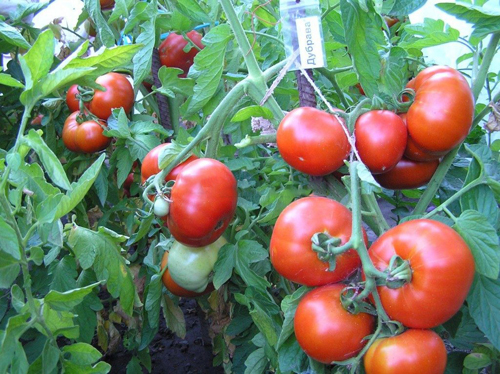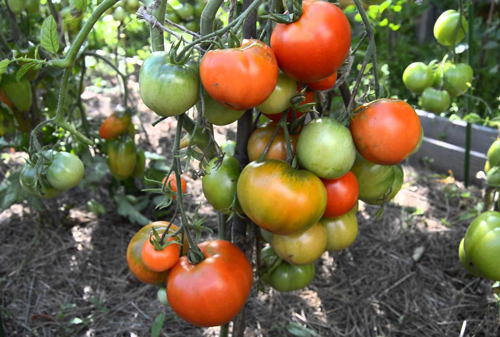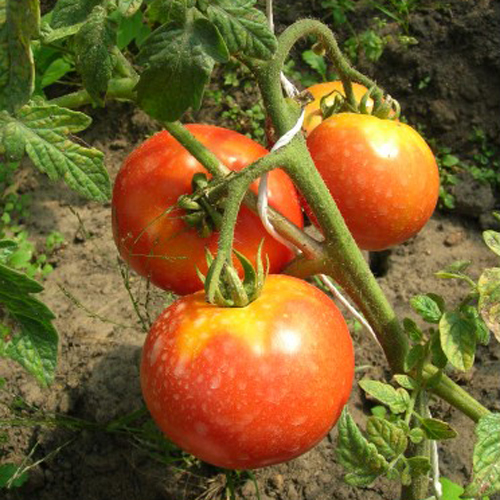Tomato variety Dubok (Dubrava)
Varietal tomatoes always surpass hybrid ones in taste, but their resistance to various diseases is not high enough. This is exactly what breeders are working on, instilling good immunity in varietal plants. The Federal State Budgetary Scientific Institution "Federal Scientific Center of Vegetable Growing" has created a wonderful tomato, which is now known as Dubok. But at the beginning of its history, it bore a different name - Dubrava, it was under it that the novelty was entered into the State Register of Breeding Achievements of the Russian Federation in 1997. The variety is approved for growing in two regions - Central (Smolensk, Bryansk, Tula, Vladimir, Kaluga, Moscow, Ryazan, Ivanovo regions) and Volgo-Vyatka (Republics of Mari El, Udmurt and Chuvash, Perm Territory, Nizhny Novgorod, Kirov, Sverdlovsk regions) ... The variety is recommended for growing outdoors in garden plots, in private and small farms.

Description
The plant is determinate, slightly branched, compact. The usual height is 40 - 55 cm, but not higher than 70 cm. The leafiness is moderate. Leaves are light green, regular, small, slightly wrinkled. The petiole is not very long, medium thick. The internodes are not long. The name stuck to the tomato because of its appearance, somewhat reminiscent of an oak, of course, in a reduced size. Inflorescences are compact, simple type. The first fruit cluster is laid over 6 - 7 leaves, then they are formed after 1 - 2 leaves. In total, 5 - 6 racemes are formed on the main stem of the Oak, each of which contains about 4 - 5 ovaries.
Fruits are round or flat-round, ribbing is poorly expressed. The skin is not very thick, dense, smooth, glossy. A ripe tomato has an even red color. The pulp is quite dense, fleshy, moderately dry. The number of seed nests is from 3 to 6. The usual weight is 53 - 110 grams, but 200-gram specimens can ripen on the lower clusters. The pulp tastes sweet and sour, aromatic. The State Register of Plants of the Russian Federation describes the taste of fresh fruits as satisfactory and good.

Variety characteristics
- Dubok (Dubrava) belongs to the early ripening varieties, ripening occurs 85 - 105 days after the emergence of full shoots. The first reddened tomatoes can be removed in June;
- the yield for a short plant is very good. In the central region, it amounted to 133 - 349 c / ha, which is 24 - 106 c / ha higher than those taken for the standard Alpatiev 905 A and Peremog 165. In the Volga-Vyatka region, the yield ranges from 224 - 551 c / ha, but the standards Peremoga 165 and Siberian early maturing, this figure was 286 - 539 c / ha. The maximum amount was recorded in the Republic of Mari El - 551 c / ha, which is 12 c / ha higher than that of the Siberian early ripening variety, taken as the standard. If we turn to the messages of the forum, then from one square meter of the plot, gardeners collect, on average, 5 kg of fruits;

- Dubok's immunity is quite high, the susceptibility to late blight of the vegetative mass is above average;
- high adaptability, tomato is valued for its cold resistance and resistance to day and night temperature extremes;
- high-quality fruits perfectly withstand transportation and are stored for up to 1.5 months;
- every housewife will be able to use the crop at her discretion. Tomatoes are an excellent ingredient for salads, suitable for pickling, pickling, canning and processing into tomato products.
Agrotechnics
The variety is not only suitable for open ground, it can be cultivated under a film shelter in cooler regions. But for this it is best to grow the Oak in a seedling way. Sowing seeds is carried out in March or April, depending on climatic conditions. The pick is made in the phase of 2 true leaves. Seedlings are planted on the garden bed after 2 months. In the southern regions, it can be sown with seeds directly into the ground, this procedure is carried out in late April - early May. In this case, it will take a little longer to wait for the harvest, but warm weather will allow the plant to bear fruit until September - October.Planting pattern - 30 cm between bushes, row spacing - 70 cm. Recommended density per 1 square meter - 6 - 8 plants. It is not necessary to carry out the picking, but it is still better to tie it up to the support, otherwise, under the load of fruits, the bush may fall on its side. It is advisable to water the tomato after lunch, making sure that moisture does not get on the leaves. The rest of the care corresponds to the agricultural technology of the culture as a whole - feeding, loosening, preventive treatments and weeding.
Oak (Dubrava) is an excellent plant for gardeners who do not have the opportunity to take care of the plantings daily. The variety allows, with very simple maintenance, to easily get a good early harvest, which can be used in a universal way. The seed can be collected by yourself.









Pleasant taste, good for fresh vegetable salads. Due to the small size and dense pulp of the fruit, it is suitable for pickling, especially if you are not rich in large-volume jars - even a liter contains a sufficient amount of tomatoes. Pros: ripens first, does not require a garter (the bush is about knee-deep, sometimes lower), resistant to phytophthora, takes root well. There was an invasion of the moth that summer, and so its caterpillars did not eat Oak. Cons: I have been planting for several years, but every year the bush begins to dry, and the fruits wrinkle after 1.5 months of fruiting, I see no objective reasons.
Two years ago, I decided to try earlier tomatoes than were on my site. The seller advised me the Dubok variety. Then I made the first mistake in growing this variety, planting the bushes at a great distance from each other. This should not have been done, since it has a very weak branching, with a small amount of foliage. Therefore, for a more efficient use of the area, these tomatoes should be planted at a short distance from each other - 30 - 40 cm.
The first fruits began to appear two months later (from the beginning of planting seedlings in the ground). The fruits are small - weighing about 70 grams, all of the same size. The skin is quite dense, suitable for preservation. Although I prefer later and dense varieties for conservation. I use the oak for salads. It has good gustatory qualities, the taste is sweetish with sourness. It is believed that you do not need to tie it up, but I would still advise tying up the bushes, especially in windy regions. Despite being an early variety, it is quite disease resistant. But I still advise you to treat phytophthora. Since the large crowding of fruits can contribute to this disease. I liked the variety, so I'm going to grow it in the future.
I have been growing it for many years. Never fails. Even in the most lean years, it pleases with fruits. I plant only in open ground through seedlings. I also tie up my stepson. I tried to refuse it, but the stems bend and the fruits end up on the ground, and if you leave a lot of stepsons, then the tomatoes do not have time to ripen. I take off the first largest fruits at the end of July and put them in boxes to ripen. The rest of the tomatoes gain weight quickly and begin to turn red in early August. Phytophthora does not exist, except for a very rainy summer. I use these tomatoes for pickling.